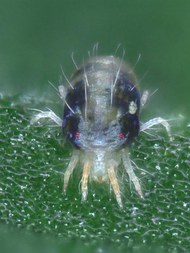Extreme Adaptation Mechanisms Unraveled in Agricultural Pest Spider Mites
(09-10-2023) The spider mite possesses a range of detoxification mechanisms to protect itself against chemical pesticides and chemical plant defenses. Researchers Marilou Vandenhole and Berdien De Beer have mapped out these mechanisms.
The spider mite Tetranychus urticae is one of the most voracious agricultural pests worldwide. These herbivores thrive on a record number of different plants and crops, causing massive damage to global agriculture. Although they are combated with chemical pesticides, and plants defend themselves against feeding through chemical warfare, mites can quickly turn specific detoxification mechanisms on and off to adapt to these toxins.
How they do this was unknown until now, not only among mites but also other arthropods. Using genetic experiments, these researchers unraveled the genetic variation responsible for differences in the specificity and strength of detoxification mechanisms (an eQTL experiment).
They found that one specific location in the genome was responsible for significant differences in the expression of genes involved in adaptation and detoxification among the studied populations. This discovery also revealed a new family of transcription factors, specifically proteins that regulate the switching on and off of genes. The presence of a large and unique family of these genes in T. urticae might explain how these organisms can adapt so quickly to different plants and, most importantly, how they can rapidly develop resistance to pesticides. The discovery could potentially lead to better pest control.
The researchers published their findings in an article in Nature Communications.

